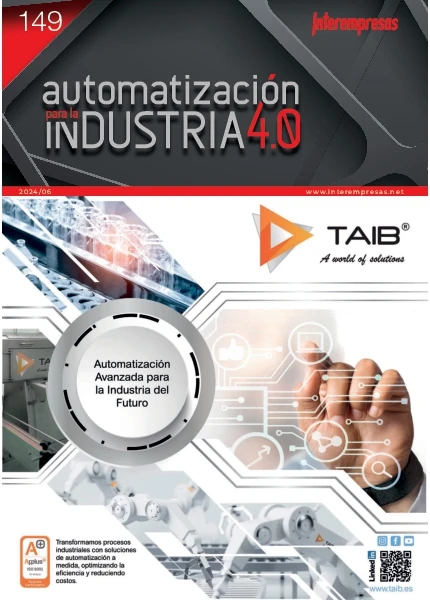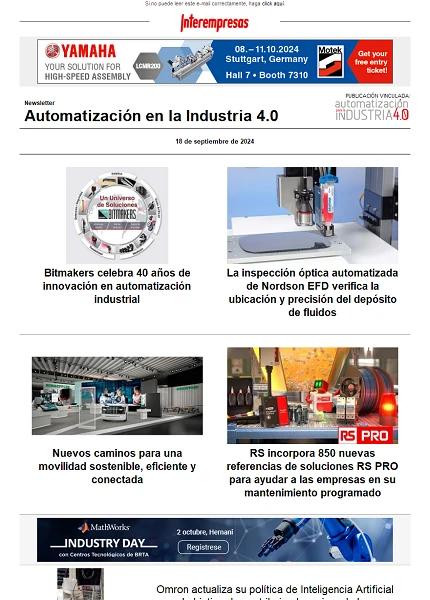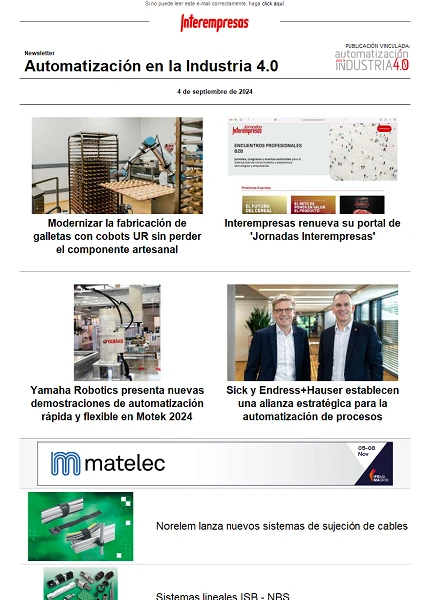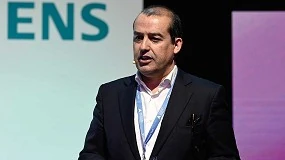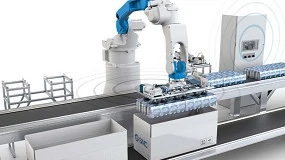Las redes inalámbricas permiten obtener información en tiempo real
Redes inalámbricas de sensores en aplicaciones agroambientales
Muchas de las aplicaciones actuales de la electrónica dependen de sensores que obtienen las señales necesarias para monitorizar o controlar procesos de índole tan variada como el número de vehículos en un aparcamiento o la iluminación de la pantalla de un teléfono móvil. Cuando la información se utiliza en un punto distinto de aquél donde se ha obtenido, por ejemplo porque es inaccesible al usuario o porque la información deseada se obtiene al combinar aquella proporcionada por múltiples sensores dispersos, surge el problema de la comunicación de las señales del sensor al procesador final. Cuando dicha comunicación no se puede basar totalmente en una red preexistente, la solución es implantar una red inalámbrica que comunique los sensores a dicha red, y a veces también entre sí. Esta situación se da con frecuencia en aplicaciones agroambientales porque éstas se suelen implementar en zonas con baja densidad de población y por ende de redes de comunicación
Introducción
Un sensor electrónico es todo dispositivo que ofrezca una salida eléctrica a partir de una magnitud física o química. Este término sugiere una capacidad de extensión de nuestros sentidos, que es cierta en lo que se refiere al número de magnitudes que podemos percibir directamente con nuestra vista, oído, olfato gusto y tacto; pero dicha extensión es menos cierta en cuanto a alguna de las capacidades de percepción de las máquinas, que todavía no superan las de los seres vivos. Los sensores se basan en el cambio de geometría en un componente electrónico o en los cambios que experimentan las propiedades de los materiales que los constituyen cuando son expuestos a la magnitud que se desea medir. Las señales obtenidas a partir de dichos cambios son muy pequeñas y para comunicarlas hay que procesarlas previamente, tal como se indica en la figura 1. Para poder establecer una comunicación bidireccional, el emisor debe actuar alternativamente como receptor y viceversa (transceptor).

Los circuitos electrónicos de procesamiento y comunicación, y a menudo también el sensor, necesitan una alimentación eléctrica para poder funcionar. En las redes inalámbricas de sensores, la solución más habitual es la captación de energía solar porque en instalaciones remotas permanentes la sustitución frecuente de baterías primarias sería una solución ineficiente. Una gestión adecuada de la energía captada permite alimentar el conjunto con células solares de dimensiones muy reducidas, e implica el diseño de circuitos electrónicos de muy bajo consumo que logran que la célula solar trabaje siempre en su punto de máximo rendimiento. La fuente de alimentación del receptor se puede basar también en energía solar, o estar conectada a la red de suministro eléctrico.
La gestión eficiente de la energía conlleva también una selección adecuada de la frecuencia con que se realizan las mediciones, porque cuando no se está midiendo, el sensor y los circuitos asociados se desconectan para ahorrar energía. El tiempo mínimo entre mediciones vendrá determinado por la dinámica de la magnitud que se desea medir. Análogamente, y con mayor razón debido al elevado consumo del transceptor respecto al del sensor y el procesador, los resultados de las mediciones es preferible transmitirlos por paquetes si no es imprescindible transmitirlos justo después de haberlos obtenido.
Una comunicación eficaz exige unas reglas que constituyen el ‘protocolo’: formatos de las señales, detección y corrección de errores, acceso al medio de comunicación (aquí, el aire), es decir, arbitrar quién actúa como emisor y receptor en cada momento, etc. Para pasar información entre sistemas que tienen protocolos distintos se emplean ‘pasarelas’ o ‘puentes’ (gateways, bridges), y éste suele ser el caso en las redes de sensores en aplicaciones agroambientales porque la información obtenida acaba siendo comunicada finalmente a través de una red de comunicación preexistente.
Para evitar que los sistemas de radiocomunicación en el aire interfieran entre sí, hay una regulación mundial que asigna bandas de frecuencia a las distintas aplicaciones: radiodifusión, radionavegación, televisión, radioenlaces, comunicaciones marítimas, comunicaciones militares, aplicaciones industriales, científicas y médicas (ISM), etc. Para la aplicaciones ISM hay asignadas diversas bandas ‘libres’, es decir, no es necesario pedir permiso para operar en ellas si la potencia transmitida no excede unos límites establecidos. Estas bandas dependen de la zona geográfica. El resultado de esta regulación es una gran variedad de protocolos estandarizados para trabajar en cada una de las bandas ISM sin interferirse mutuamente. La tabla 1 recoge algunas características básicas de las normas más utilizadas.
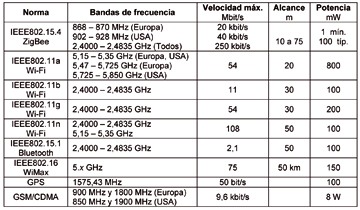
La frecuencia de transmisión influye en la capacidad del canal: a mayor frecuencia, más canales se pueden transmitir, o se puede transmitir datos a una mayor velocidad para un determinado número de canales, y menor es el tamaño de las antenas necesarias. Pero, para una misma potencia transmitida, el alcance disminuye al aumentar la frecuencia porque los obstáculos en el camino de propagación de las ondas absorben más las señales. La figura 2 muestra la relación entre potencia y velocidad de transmisión de datos según la extensión del área geográfica cubierta.
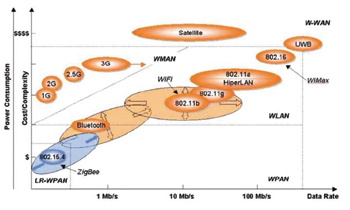
Las aplicaciones previstas inicialmente en cada norma son acordes con su ancho de banda (velocidad de transmisión): ZigBee para monitorización, Wi-Fi para transmitir voz y datos, Bluetooth para sustituir cables entre equipos multimedia, WiMax para aumentar el ancho de banda en las comunicaciones móviles, etc. No obstante, el amplio uso de todos estos estándares, sobre todo cuando se aplican en productos de consumo, hace que el precio de los circuitos integrados necesarios para implementarlos decrezca hasta el punto de que su uso en aplicaciones industriales sea una opción razonable, cuando por su menor volumen de mercado no justificarían el diseño de circuitos integrados específicos.
Otra decisión importante en las redes inalámbricas de sensores es su topología, es decir, la disposición espacial de los nodos de la red y la funcionalidad de cada uno de ellos, porque determina el área cubierta, la fiabilidad de la comunicación y el consumo de energía. La figura 3 muestra tres disposiciones comunes en redes inalámbricas de sensores. En una red en estrella, como las utilizadas en telefonía móvil, Bluetooth y Wi-Fi, todo el tráfico pasa por un punto de acceso (pasarela), que es un nodo con mayor capacidad que enlaza con otra red de comunicaciones, fija o sin hilos. En una red arborescente o en racimo (cluster tree), cada nodo se comunica sólo con el nodo más próximo, de manera que los nodos más cercanos al punto de acceso soportan un mayor tráfico, y por lo tanto consumen más energía. Un fallo (‘caída’) en uno de estos nodos deja incomunicados a todos los nodos que están ‘por debajo’ de él. En una red en malla (mesh), cada nodo se puede comunicar con todos sus vecinos (más o menos próximos), de manera que es posible definir rutas de comunicación en función de múltiples parámetros, como por ejemplo el estado de carga de la batería en un nodo concreto. El número máximo de nodos que se pueden conectar a un mismo servidor depende de la norma: 7 en Bluetooth, 32 en Wi-Fi y hasta 64.000 en ZigBee.

Las aplicaciones agroambientales se pueden beneficiar también de estas tecnologías desarrolladas inicialmente para aplicaciones con un número de implantaciones muy elevado. Así, por ejemplo, la denominada agricultura de precisión aspira a gestionar la variabilidad de las condiciones locales para aportar sólo los recursos (semillas, agua, fertilizante, productos fitosanitarios…) necesarios en cada lugar y momento, y para predecir las cosechas. Esto exige conocer las condiciones locales del suelo, meteorológicas y ambientales, y la evolución de los cultivos. La detección remota desde satélites o aviones aporta parte de la información necesaria, pero no sobre variables tales como el nitrógeno en el suelo o la velocidad del viento. Además, sólo es económicamente justificable en explotaciones muy grandes. Las redes inalámbricas de sensores pueden aportan dicha información local.
A continuación se describen dos aplicaciones de índole muy distinta que son una muestra de las posibilidades de esta tecnología nacida al amparo del desarrollo de las telecomunicaciones móviles y los dispositivos electrónicos personales.
Monitorización de la salinidad del agua en el cultivo de arroz
La salinidad del agua tiene una repercusión negativa en la producción de arroz. En la zona Mediterránea, la extracción de agua del subsuelo hace que el agua del mar entre en las capas freáticas con la consiguiente salinización del agua y del suelo anexo, reduciendo las cosechas. La solución es regar abundantemente con agua dulce que evite que el agua salada del subsuelo ascienda hasta las raíces del arroz. En las zonas arroceras que riegan con agua de río donde la marea o el estiaje combinado con el viento provocan una cuña salina que puede penetrar varios quilómetros aguas arriba de la desembocadura del río, el riego con agua de dicha cuña causaría también daños graves al arroz. Por consiguiente, el conocimiento de la salinidad del agua es esencial para una gestión eficiente del agua de riego y proteger el arroz.
El método habitual para determinar rápidamente la salinidad del agua es medir su conductividad eléctrica: cuanta más sal, más iones y por lo tanto mejor es la conductividad. Pero en el mercado no hay sistemas que permitan medir dicha conductividad continuamente en un arrozal, entre otras razones porque la lectura del valor medido por los instrumentos actuales es presentada normalmente en una pequeña pantalla alfanumérica (figura 4). Además, la sonda está diseñada para ser sostenida manualmente dentro del agua, y limpiarla después de cada uso. Lo que interesaría es un sistema capaz de medir continuamente la conductividad y transmitir el resultado a un centro de seguimiento para que se pudiera, por ejemplo, detener el bombeo de agua salada hacia los canales de riego o aumentar el caudal de éstos para acelerar el proceso de ‘lavado’ del suelo.
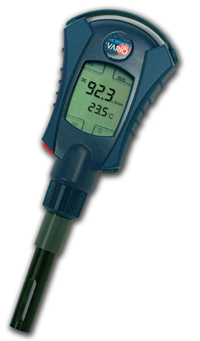
Para afrontar este problema, la Unión Europea ha financiado un proyecto de investigación de dos años denominado Smart Paddy cuyo objetivo era desarrollar una red inalámbrica de sensores autónomos que midiera en tiempo real la conductividad del agua en el desagüe de los arrozales, canales de riego, estaciones de bombeo y canales de drenaje, y presentara esta información a través de una aplicación web. De esta forma se evitarían los frecuentes viajes al campo para detectar posibles síntomas de debilitamiento de las plantas por culpa de la salinidad del agua. Para que la solución fuera económicamente viable, se consideró que cada punto de medida no debía ser mucho más caro que un medidor manual de prestaciones metrológicas comparables a las de los instrumentos de que disponen algunos agricultores o centros de apoyo.
Con estas especificaciones de diseño, la mejor solución era una red inalámbrica de sensores autónomos de conductividad eléctrica donde el sensor de conductividad de cada nodo debía ser mucho más económico que los medidores actuales porque debería incorporar además un transceptor y un sistema alimentación basado en células solares, y debía funcionar correctamente durante los más de 5 meses que dura el cultivo del arroz en el área Mediterránea. Esto implicaba que había que garantizar que las mediciones fueran correctas durante todo este tiempo a pesar de las fluctuaciones de la temperatura del agua, que influyen en su conductividad eléctrica, y de la inmersión continuada, o por lo menos detectar cualquier deterioro de los electrodos de medida como resultado de la inmersión y que pudiera afectar al resultado.
Este compromiso entre buenas prestaciones, fiabilidad y robustez por un lado y bajo coste por otro, es habitual en redes de sensores. El diseño de un nodo sensor basado en sensores convencionales, cuyas prestaciones metrológicas fácilmente exceden las necesidades del problema pero cuyo consumo y factor de forma no han sido previstos para estas aplicaciones, difícilmente permite conseguir el coste deseado. Además, si el consumo excesivo se traduce en paneles solares de dimensiones considerables, el riesgo de robo o vandalismo aumenta considerablemente.
La mejor forma de resolver el compromiso planteado es mediante innovación. En Smart Paddy se ha diseñado un medidor de conductividad del agua con compensación del efecto de la temperatura, que emplea sólo dos electrodos, lo cual simplifica el diseño electrónico frente a las sondas de cuatro electrodos, sin que el resultado quede afectado por los posibles cambios de impedancia de los electrodos, y que además permite detectar un posible deterioro de éstos. El resultado es la sonda mostrada en la figura 5, donde se puede apreciar que el panel solar, dispuesto en la parte superior de la sonda, cubre menos de la mitad de la superficie disponible. Esta solución es aplicable también en la reutilización de aguas residuales y para controlar la salinidad del agua y efluentes en otras industrias.
En cuanto a la topología de la red, dado que el punto clave era la validación del sensor y obtener la información necesaria para un futuro prototipo pre-industrial, se usó comunicación en la banda de 868-870 MHz, una red en estrella con un alcance superior a los 500 m en campo abierto, un protocolo propio, y una pasarela alimentada desde la red eléctrica.
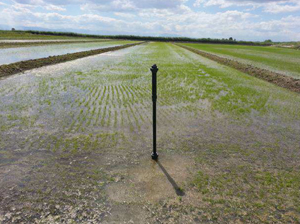
Monitorización de la temperatura y humedad en el proceso de compostaje
El compostaje es la manera natural de reciclar los residuos orgánicos para convertirlos en abono. Es un proceso biológico en el que los microorganismos, bacterias y hongos descomponen la materia orgánica. Dado que aproximadamente entre el 45 % y 55 % de los residuos generados por la acción del hombre son de materia orgánica, el compostaje juega y jugará un papel muy significativo en el tratamiento de residuos en los próximos años.
El proceso de compostaje tiene que estar bien controlado si se desea optimizar la calidad del compost resultante y minimizar aspectos negativos como son la aparición de olores o de gérmenes no deseados. La eficacia del proceso depende de las condiciones ambientales presentes en el sistema: la cantidad de oxígeno, el perfil de temperatura y humedad en las diferentes fases del proceso, y el tamaño y la actividad de las poblaciones microbianas.
Mientras que los principales parámetros físicos, biológicos y químicos que afectan al proceso de compostaje son bien conocidos, las soluciones tecnológicas disponibles para su seguimiento y control son muy limitadas. Dos de estos parámetros esenciales, la temperatura y la humedad en el interior del material sólo se miden, en la actualidad, de forma puntual, tanto temporal como espacialmente. La temperatura se mide por lo general manualmente mediante la inserción de una sonda, lo que provoca un esfuerzo humano y económico importante que impide su uso continuo. Además, automatizar estas sondas puede no ser una solución viable ante la necesidad periódica de controlar la aireación mediante el volteo de las pilas de material. En el caso de la humedad, actualmente lo habitual es estimarla mediante la extracción de muestras que deben ser analizadas en un laboratorio.
Existe, pues, una clara necesidad de proporcionar a los operadores de compostaje una mejor tecnología para el control del proceso, especialmente en vista a unas regulaciones cada vez más estrictas y a la demanda por parte del mercado de un compost de mayor calidad. El proyecto Compoball, subvencionado por la unión europea en el Séptimo Programa Marco, da respuesta a esta necesidad con el desarrollo de una red de sensores autónomos, que mide de forma continua temperatura y humedad desde el interior del material durante todo el proceso de compostaje (superior a cien días). Para conseguirlo se han tenido que superar varios retos tecnológicos que buscaban adaptar la red de sensores a las duras condiciones de trabajo ambientales (temperaturas superiores a 80 °C y humedades elevadas), y presentar elevada resistencia a ataques químicos, creados por el propio proceso de descomposición del material, y gran resistencia a los golpes y movimientos generados por el proceso periódico de volteo del material. El resultado ha sido unos nodos sensores en forma de bola, protegidos con poliuretano rígido, que comunican los datos de temperatura y humedad medidos mediante comunicación inalámbrica en banda ISM (434 MHz), y que presentan un alcance de hasta 5 m en el interior del compost. Para garantizar su estanqueidad no hace falta abrir los nodos para recargar las baterías ya que éstas son recargadas con métodos inductivos. Su coste es suficientemente bajo para lograr una red con un número importante de nodos que permita caracterizar perfectamente el material a pesar de su gran heterogeneidad.
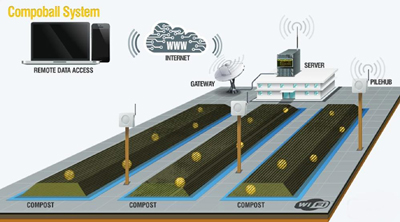
Figura 6. Arquitectura del sistema Compoball para la medida de la temperatura y humedad desde el interior de las pilas de compostaje.
Conclusión
Las redes inalámbricas de sensores son una tecnología que extiende el concepto de medidas distribuidas a situaciones donde la potencia de cálculo y la energía eléctrica disponible en cada nodo son pequeñas, pero donde la capacidad de comunicación de los nodos y su organización permiten transportar, con un coste asequible, la información hasta un punto de control que puede estar muy lejos de la zona de medida. Esto permite obtener en tiempo real información que antes sólo se podía obtener mediante registradores de datos remotos (data loggers).
Debido a su menor coste de instalación, material y tiempo respecto a las redes cableadas, y la posibilidad de autoconfigurarse para aceptar nuevos nodos, fijos o móviles, o prescindir de alguno de ellos, las redes inalámbricas de sensores van penetrando en todos los sectores productivos con una velocidad acorde a las peculiaridades de cada sector, tal como ha sucedido con otras tecnologías. Una velocidad excesiva, impulsada por la dinámica de la tecnología en sí misma, puede llevar a fracasos rotundos. Pero una velocidad demasiado lenta, normalmente fruto de la comprensible resistencia al cambio y de la prudencia frente a lo desconocido, puede ser también un síntoma inequívoco de una pérdida de competitividad que hace inevitable la desaparición en un futuro próximo.
En cualquier caso, las aplicaciones agroambientales, igual que las demás, sólo se podrán justificar si el beneficio neto supera el coste, y cuando hay muchos puntos de medida hay que diseñar nodos sensores que puede que tengan que basarse en nuevos principios de medida, quizá aprovechando microsensores desarrollados para otras aplicaciones, nuevos métodos de procesamiento de las señales o ambos y, en cualquier caso, en métodos eficientes para acondicionar la energía captada con paneles solares de dimensiones reducidas o muy reducidas.


